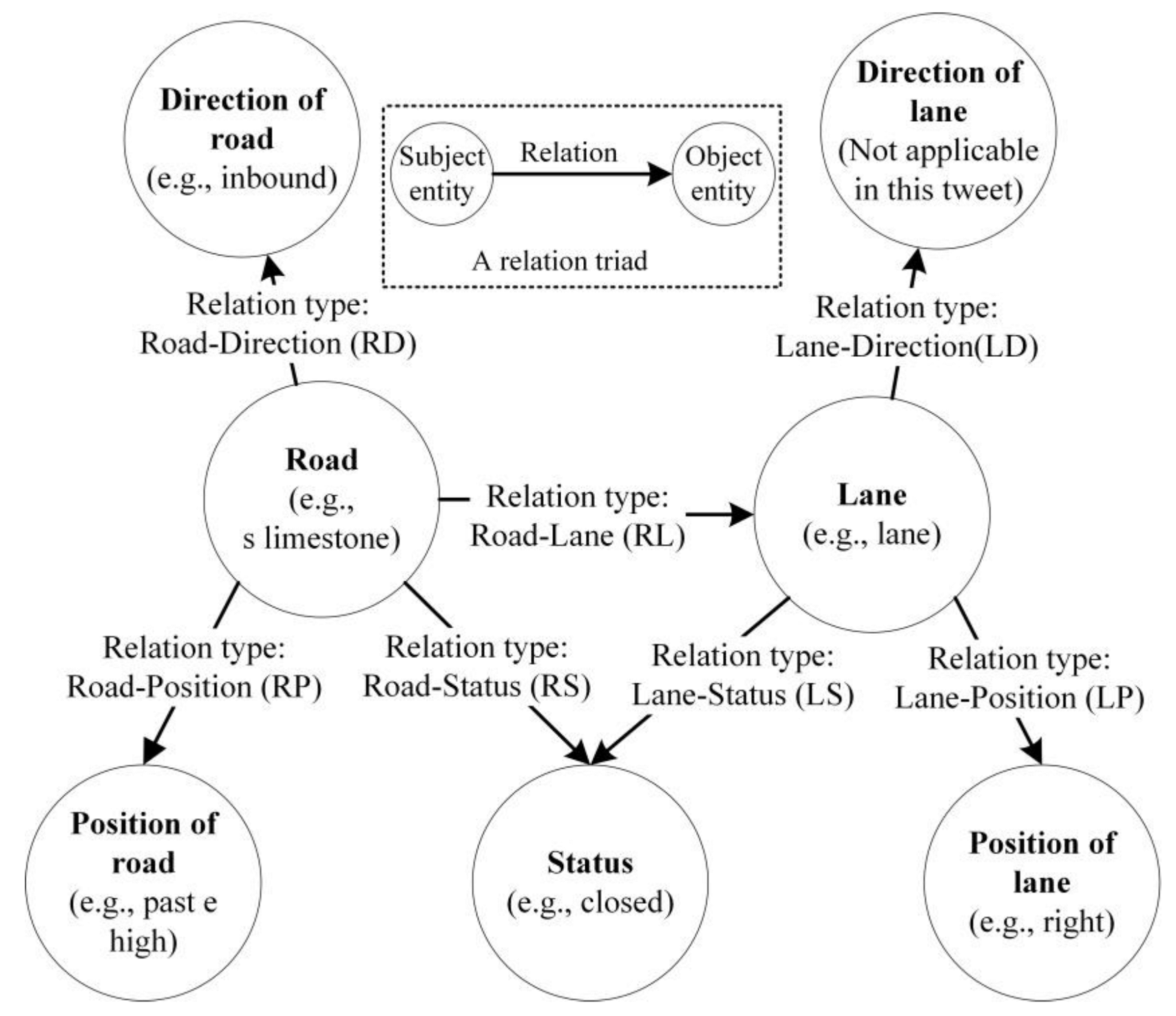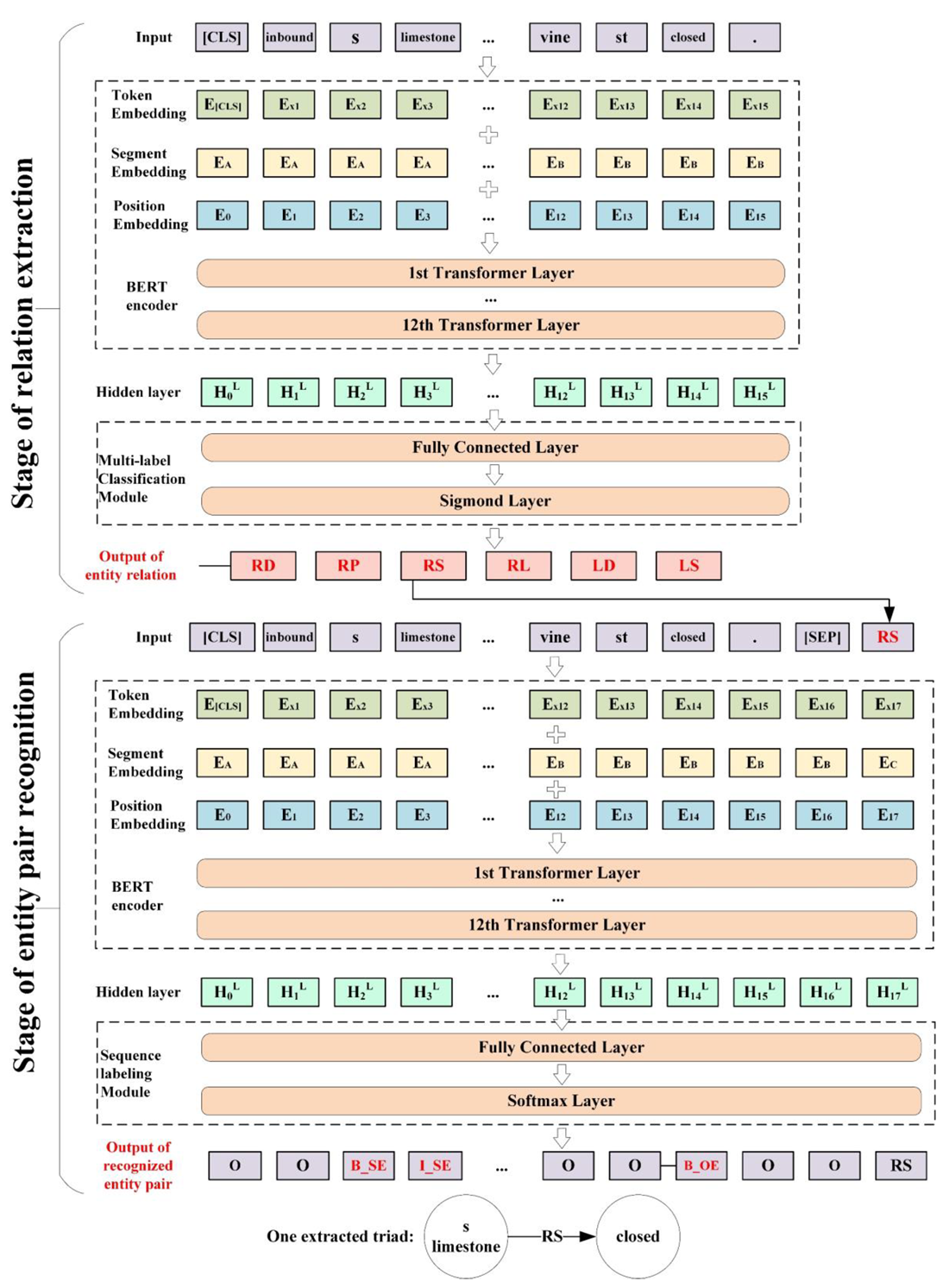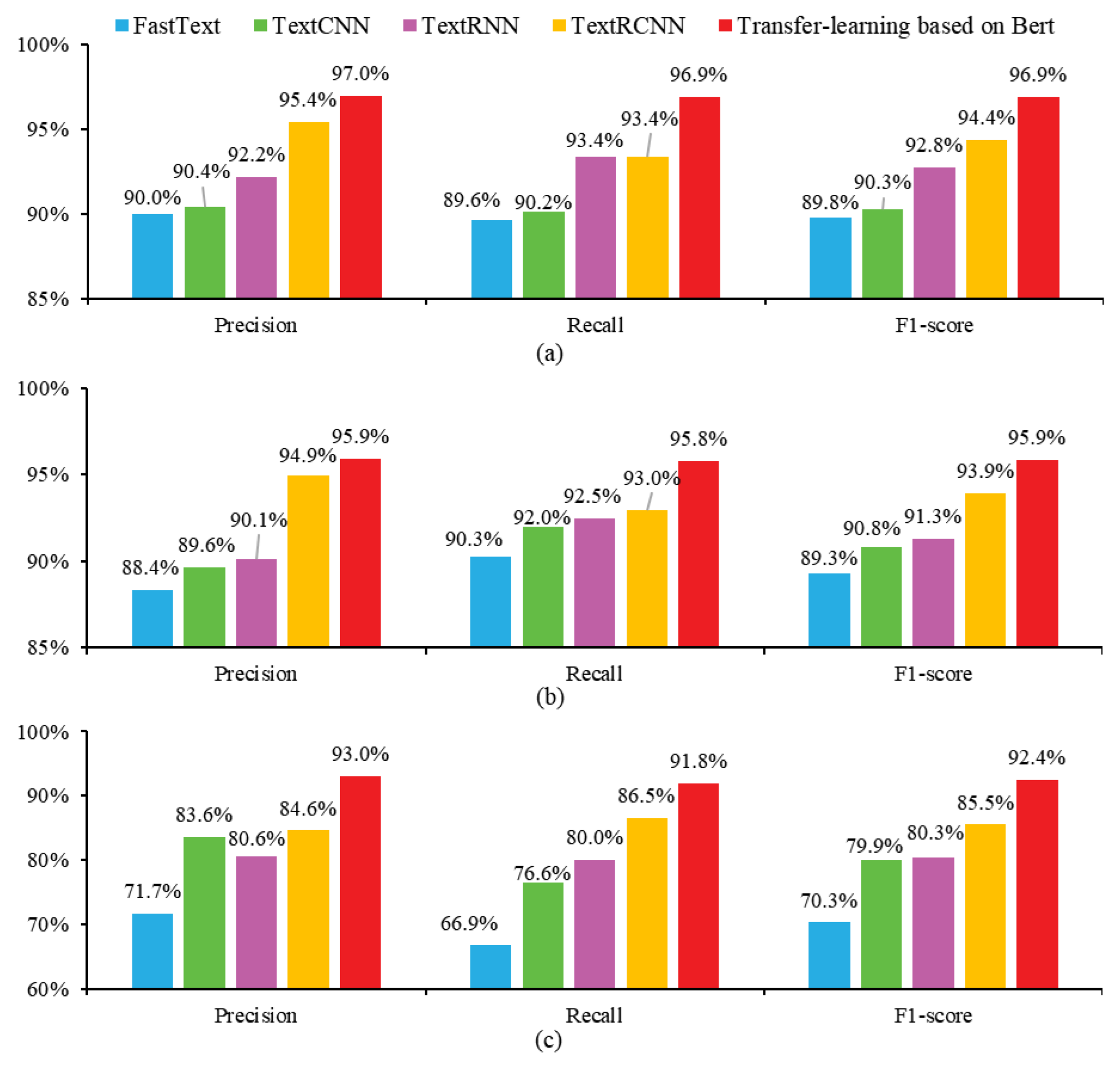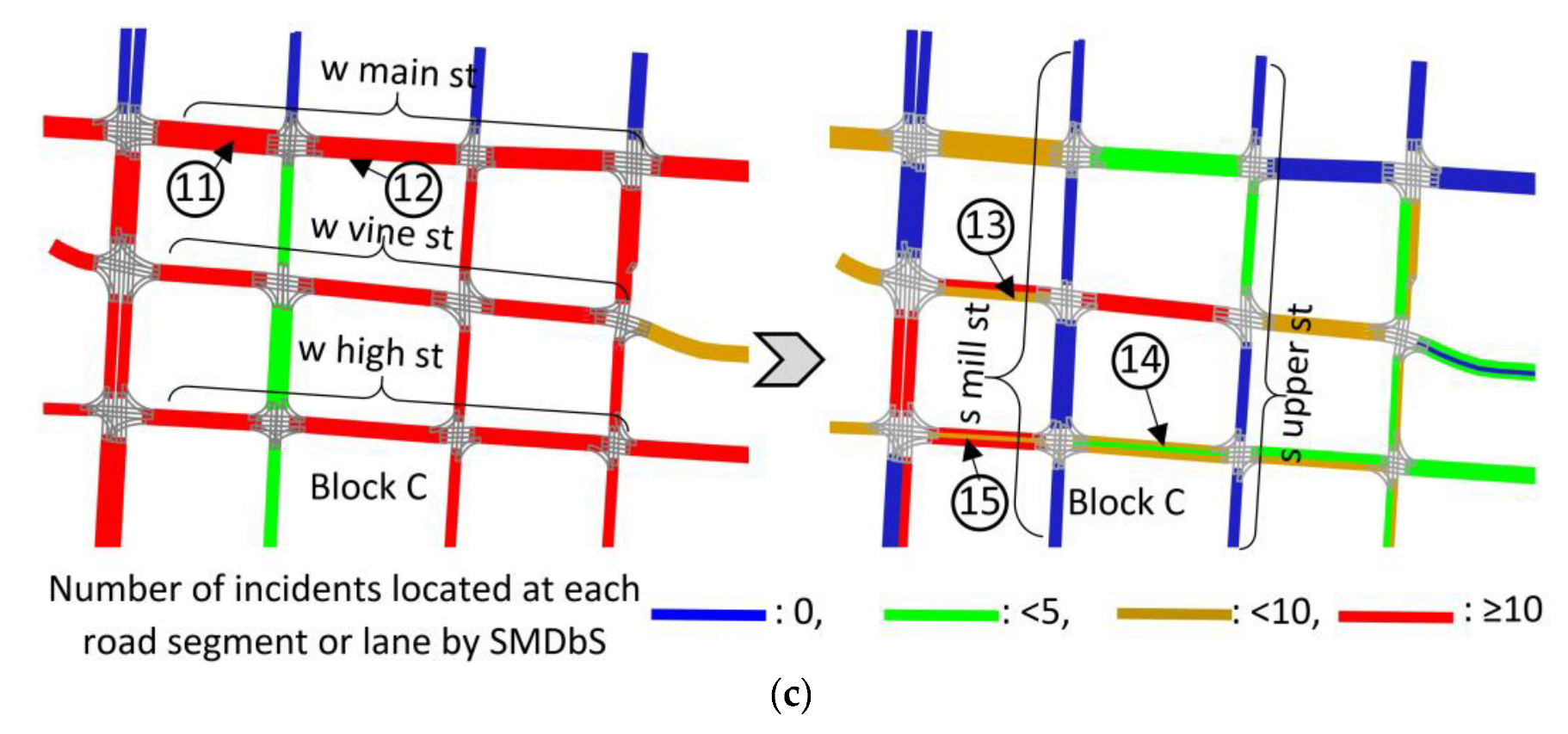Road-Related Information Mining from Social Media Data: A Joint Relation Extraction and Entity Recognition Approach
Abstract
1. Introduction
2. Literature Review
2.1. Social Media Data-Based Sensors of Road Conditions
| No. | Reference | Source | Exploited Methods | Extracted Information or Entities |
|---|---|---|---|---|
| 1 | [2] |
|
| |
| 2 | [14] | Tweet |
|
|
| 3 | [13] | Tweet |
|
|
| 4 | [6] | Tweet |
|
|
| 5 | [10] | Tweet |
|
|
| 6 | [21] |
|
| |
| 7 | [16] | Tweet |
|
|
| 8 | [15] | Tweet |
|
|
| 9 | [6] | Tweet |
|
|
| 10 | [9] | Tweet |
|
|
| 11 | [11] | Tweet |
|
|
| 12 | [20] | Tweet |
|
|
| 13 | [8] | Tweet |
|
|
2.2. Location Information Extraction from Social Media Data
2.3. Research Gaps
3. Methodology
3.1. Social Media Data Collection and Annotation
3.2. Social Media Data Cleansing
3.3. Joint Relation Extraction and Entity Recognition Model for Extracting Road-Related Information
3.3.1. Relation Extraction in Social Media Data
3.3.2. Entity Recognition for Each Extracted Relation
3.4. Model Verification
4. A Demonstrative Case
4.1. Performance of the Joint Relation Extraction and Entity Recognition Model
4.2. Granularity Improvement of the Location Information Extracted by SMDbS
5. Discussion
5.1. Contributions
5.2. Advantages and Disadvantages of Social Media Data
5.3. Reuses of the Methodology
5.4. Further Efforts
6. Conclusions
Supplementary Materials
Author Contributions
Funding
Institutional Review Board Statement
Informed Consent Statement
Data Availability Statement
Acknowledgments
Conflicts of Interest
References
- Zia, M.; Furle, J.; Ludwig, C.; Lautenbach, S.; Gumbrich, S.; Zipf, A. SocialMedia2Traffic: Derivation of Traffic Information from Social Media Data. ISPRS Int. Geo-Inf. 2022, 11, 20. [Google Scholar] [CrossRef]
- Wang, Y.; He, Z.; Hu, J. Traffic Information Mining From Social Media Based on the MC-LSTM-Conv Model. IEEE Trans. Intell. Transp. Syst. 2022, 23, 1132–1144. [Google Scholar] [CrossRef]
- Park, J.Y.; Mistur, E.; Kim, D.; Mo, Y.; Hoefer, R. Toward human-centric urban infrastructure: Text mining for social media data to identify the public perception of COVID-19 policy in transportation hubs. Sustain. Cities Soc. 2022, 76, 17. [Google Scholar] [CrossRef]
- Xu, S.; Li, S.; Wen, R. Sensing and detecting traffic events using geosocial media data: A review. Comput. Environ. Urban Syst. 2018, 72, 146–160. [Google Scholar] [CrossRef]
- Zayet, T.M.A.; Ismail, M.A.; Varathan, K.D.; Noor, R.M.D.; Chua, H.N.; Lee, A.; Low, Y.C.; Singh, S.K.J. Investigating transportation research based on social media analysis: A systematic mapping review. Scientometrics 2021, 126, 6383–6421. [Google Scholar] [CrossRef]
- Khan, S.M.; Chowdhury, M.; Ngo, L.B.; Apon, A. Multi-class twitter data categorization and geocoding with a novel computing framework. Cities 2020, 96, 102410. [Google Scholar] [CrossRef]
- Chang, H.L.; Li, L.S.; Huang, J.X.; Zhang, Q.P.; Chin, K.S. Tracking traffic congestion and accidents using social media data: A case study of Shanghai. Accid. Anal. Prev. 2022, 169, 17. [Google Scholar] [CrossRef]
- Agarwal, A.; Toshniwal, D. Face off: Travel Habits, Road Conditions and Traffic City Characteristics Bared Using Twitter. IEEE Access 2019, 7, 66536–66552. [Google Scholar] [CrossRef]
- Alhumoud, S. Twitter Analysis for Intelligent Transportation. Comput. J. 2019, 62, 1547–1556. [Google Scholar] [CrossRef]
- Paule, J.D.G.; Sun, Y.; Moshfeghi, Y. On fine-grained geolocalisation of tweets and real-time traffic incident detection. Inf. Process. Manag. 2019, 56, 1119–1132. [Google Scholar] [CrossRef]
- Yao, W.; Qian, S. From Twitter to traffic predictor: Next-day morning traffic prediction using social media data. Transp. Res. Part C Emerg. Technol. 2021, 124, 102938. [Google Scholar] [CrossRef]
- Li, J.; Sun, A.X.; Han, J.L.; Li, C.L. A Survey on Deep Learning for Named Entity Recognition. IEEE Trans. Knowl. Data Eng. 2022, 34, 50–70. [Google Scholar] [CrossRef]
- Milusheva, S.; Marty, R.; Bedoya, G.; Williams, S.; Resor, E.; Legovini, A. Applying machine learning and geolocation techniques to social media data (Twitter) to develop a resource for urban planning. PLoS ONE 2021, 16, e0244317. [Google Scholar] [CrossRef] [PubMed]
- Yuan, F.; Liu, R.; Mao, L.; Li, M. Internet of people enabled framework for evaluating performance loss and resilience of urban critical infrastructures. Saf. Sci. 2021, 134, 105079. [Google Scholar] [CrossRef]
- Chen, Y.; Wang, Q.; Ji, W. Rapid Assessment of Disaster Impacts on Highways Using Social Media. J. Manag. Eng. 2020, 36, 04020068. [Google Scholar] [CrossRef]
- Essien, A.; Petrounias, I.; Sampaio, P.; Sampaio, S. A deep-learning model for urban traffic flow prediction with traffic events mined from twitter. World Wide Web 2021, 24, 1345–1368. [Google Scholar] [CrossRef]
- Chaniotakis, E.; Antoniou, C.; Pereira, F. Mapping Social Media for Transportation Studies. IEEE Intell. Syst. 2016, 31, 64–70. [Google Scholar] [CrossRef]
- Chen, J.V.; Nguyen, T.; Oncheunjit, M. Understanding continuance intention in traffic-related social media Comparing a multi-channel information community and a community-based application. Internet Res. 2020, 30, 539–573. [Google Scholar] [CrossRef]
- Berube, M.; Tang, T.U.; Fortin, F.; Ozalp, S.; Williams, M.L.; Burnap, P. Social media forensics applied to assessment of post-critical incident social reaction: The case of the 2017 Manchester Arena terrorist attack. Forensic Sci. Int. 2020, 313, 9. [Google Scholar] [CrossRef] [PubMed]
- Martínez, N.J.F.; Pascual, C.P. Knowledge-based rules for the extraction of complex, fine-grained locative references from tweets. Rev. Electron. De Linguist. Apl. 2020, 19, 136–163. [Google Scholar]
- Li, X.; Zhou, J.; Pedrycz, W. Linking granular computing, big data and decision making: A case study in urban path planning. Soft Comput. 2020, 24, 7435–7450. [Google Scholar] [CrossRef]
- Rettore, P.H.L.; Santos, B.P.; Lopes, R.R.F.; Maia, G.; Villas, L.A.; Loureiro, A.A.F. Road Data Enrichment Framework Based on Heterogeneous Data Fusion for ITS. IEEE Trans. Intell. Transp. Syst. 2020, 21, 1751–1766. [Google Scholar] [CrossRef]
- Tang, J.; Tang, X.Y.; Yuan, J.S. Traffic-optimized Data Placement for Social Media. IEEE Trans. Multimed. 2018, 20, 1008–1023. [Google Scholar] [CrossRef]
- Shen, D.Y.; Zhang, L.F.; Cao, J.P.; Wang, S.Z. Forecasting Citywide Traffic Congestion Based on Social Media. Wirel. Pers. Commun. 2018, 103, 1037–1057. [Google Scholar] [CrossRef]
- Twitter. Filtering Tweets by location. Available online: https://developer.twitter.com/en/docs/tutorials/filtering-tweets-by-location (accessed on 25 June 2015).
- Mahmud, J.; Nichols, J.; Drews, C. Home location identification of twitter users. ACM Trans. Intell. Syst. Technol. (TIST) 2014, 5, 1–21. [Google Scholar] [CrossRef]
- Salazar-carrillo, J.; Torres-ruiz, M.; Davis, C.A., Jr.; Quintero, R.; Moreno-ibarra, M.; Guzmán, G. Traffic congestion analysis based on a web-gis and data mining of traffic events from twitter. Sensors 2021, 21, 2964. [Google Scholar] [CrossRef]
- Yang, T.; Xie, J.; Li, G.; Mou, N.; Chen, C.; Zhao, J.; Liu, Z.; Lin, Z. Traffic Impact Area Detection and Spatiotemporal Influence Assessment for Disaster Reduction Based on Social Media: A Case Study of the 2018 Beijing Rainstorm. ISPRS Int. Geo-Inf. 2020, 9, 136. [Google Scholar] [CrossRef]
- Goyal, A.; Gupta, V.; Kumar, M. Recent named entity recognition and classification techniques: A systematic review. Comput. Sci. Rev. 2018, 29, 21–43. [Google Scholar] [CrossRef]
- Wang, D.; Al-Rubaie, A.; Clarke, S.S.; Davies, J. Real-Time Traffic Event Detection From Social Media. ACM Trans. Internet Technol. 2017, 18, 23. [Google Scholar] [CrossRef]
- Lu, H.; Zhu, Y.F.; Shi, K.Z.; Lv, Y.S.; Shi, P.F.; Niu, Z.D. Using Adverse Weather Data in Social Media to Assist with City-Level Traffic Situation Awareness and Alerting. Appl. Sci. 2018, 8, 18. [Google Scholar] [CrossRef]
- Devlin, J.; Chang, M.-W.; Lee, K.; Toutanova, K. Bert: Pre-training of deep bidirectional transformers for language understanding. arXiv 2018, arXiv:1810.04805. [Google Scholar]
- Zhang, Z.H.; He, Q.; Gao, J.; Ni, M. A deep learning approach for detecting traffic accidents from social media data. Transp. Res. Pt. C-Emerg. Technol. 2018, 86, 580–596. [Google Scholar] [CrossRef]
- Li, D.W.; Zhang, Y.J.; Li, C. Mining Public Opinion on Transportation Systems Based on Social Media Data. Sustainability 2019, 11, 15. [Google Scholar] [CrossRef]
- Rashid, M.T.; Zhang, D.; Wang, D. DASC: Towards a road Damage-Aware Social-media-driven Car sensing framework for disaster response applications. Pervasive Mob. Comput. 2020, 67, 23. [Google Scholar] [CrossRef]
- Ghandour, A.J.; Hammoud, H.; Dimassi, M.; Krayem, H.; Haydar, J.; Issa, A. Allometric scaling of road accidents using social media crowd-sourced data. Phys. A Stat. Mech. Its Appl. 2020, 545, 8. [Google Scholar] [CrossRef]
- Lock, O.; Pettit, C. Social media as passive geo-participation in transportation planning-how effective are topic modeling & sentiment analysis in comparison with citizen surveys? Geo-Spatial Inf. Sci. 2020, 23, 275–292. [Google Scholar]








| Sources | Methods | The Granularities of Location Information | ||
|---|---|---|---|---|
| Nation, State, County, or City | Road | Road Segment or Lane | ||
| User profile | Read the location field in the user profile | √ | × | × |
| Geotag | Read the texts of geotags | √ | √ | × |
| Read the coordinates from the tweet API | √ | √ | × | |
| Textual content | Recognize location entities | √ | √ | × |
| Extract entities and relations in this study | √ | √ | √ | |
| Category of Keywords | Keywords | References |
|---|---|---|
| Road-related keywords | road, rd, way, street, st, avenue, ave, boulevard, blvd, lane, ln, drive, dr, terrace, ter, place, pl, court, ct, fwy, freeway, alley, aly, boulevard, loop, circle, pass, ramp, pike, pkwy | [1,2,30] |
| Consequence-related keywords | shutdown, close, incident, accident, crash | [10,15] |
| Vehicle-related keywords | vehicle, car, bus, vehicular, traffic | [5,11] |
| Codes in Figure 6 | Examples of Segment or Lane * | Number of Incidents that Occur on this Segment or Lane | |
|---|---|---|---|
| Existing SMDbS (Table 1) | The Newly Devised SMDbS | ||
| No.1 | segment of w maxwell st between s upper st and jersey st | 13 | 2 |
| No.2 | segment of pine st between s broadway and plunkett st | 7 | 2 |
| No.3 | segment of s upper st between pine st and cedar st | 14 | 3 |
| No.4 | segment of s limestone between pine st and winslow st | 16 | 6 |
| No.5 | segment of broadway between pine st and cedar st | 19 | 7 |
| No.6 | segment of e main st between esplanade and s martin luther king road | 11 | 3 |
| No.7 | central lane of e vine st between quality st and rose st | 9 | 1 |
| No.8 | leftmost lane of e vine st between s martin luther king road and beck alley | 9 | 2 |
| No.9 | segment of e high st between hagerman ct and stone ave | 15 | 4 |
| No.10 | segment of e maxwell st between stone ave and rose st | 12 | 4 |
| No.11 | segment of w main st between s broadway and s mill st | 13 | 8 |
| No.12 | segment of w main st between s mill st and s upper st | 13 | 3 |
| No.13 | right lane of w vine st between s broadway and s mill st | 15 | 5 |
| No.14 | central lane of w high st between s mill st and s upper st | 26 | 3 |
| No.15 | central lane of w high st between s broadway and s mill st | 26 | 6 |
Disclaimer/Publisher’s Note: The statements, opinions and data contained in all publications are solely those of the individual author(s) and contributor(s) and not of MDPI and/or the editor(s). MDPI and/or the editor(s) disclaim responsibility for any injury to people or property resulting from any ideas, methods, instructions or products referred to in the content. |
© 2022 by the authors. Licensee MDPI, Basel, Switzerland. This article is an open access article distributed under the terms and conditions of the Creative Commons Attribution (CC BY) license (https://creativecommons.org/licenses/by/4.0/).
Share and Cite
Yu, L.; Li, D. Road-Related Information Mining from Social Media Data: A Joint Relation Extraction and Entity Recognition Approach. Buildings 2023, 13, 104. https://doi.org/10.3390/buildings13010104
Yu L, Li D. Road-Related Information Mining from Social Media Data: A Joint Relation Extraction and Entity Recognition Approach. Buildings. 2023; 13(1):104. https://doi.org/10.3390/buildings13010104
Chicago/Turabian StyleYu, Lei, and Dezhi Li. 2023. "Road-Related Information Mining from Social Media Data: A Joint Relation Extraction and Entity Recognition Approach" Buildings 13, no. 1: 104. https://doi.org/10.3390/buildings13010104
APA StyleYu, L., & Li, D. (2023). Road-Related Information Mining from Social Media Data: A Joint Relation Extraction and Entity Recognition Approach. Buildings, 13(1), 104. https://doi.org/10.3390/buildings13010104








